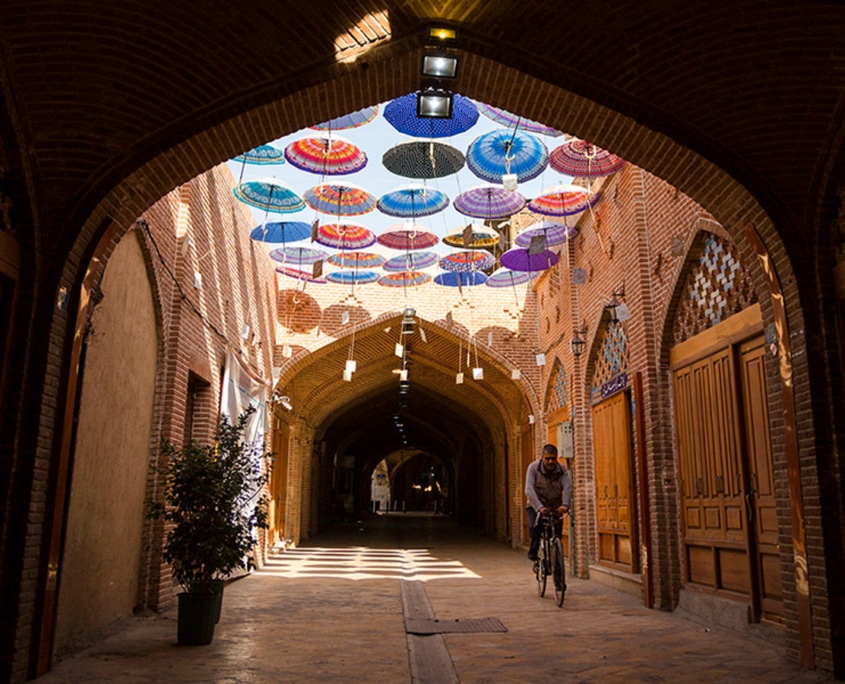Oudlajan in Tehran

Located in the area of Tehran’s Grand Bazaar, Oudlajan is a beautiful old neighborhood of the capital city which is nothing like you would expect in the crowdedness of central Tehran! Take the time to visit the nice paved alleys to have the feeling of going on a trip to a hundred years back.
Contents
What is Oudlajan?

Oudlajan is one of the oldest neighborhoods of Tehran. Located in what is now Tehran’s central area, it is encompassed by Tehran Grand Bazaar on the south and the area around Baharestan Square on the north. Yet, at the time the neighborhood started to develop, Tehran was still a modest village, and Oudlajan was occupying the northeastern part of the city.
By the time it became the capital of Persia, under the Qajar era, Oudlajan had consisted of 2619 houses and 1146 shops, which made it one of the wealthiest neighborhoods of the city. As it covers a vast area, it can be divided into three parts: Pamenar, Imamzadeh Yahya and Naser Khosrow.
The name of the neighborhood itself tells us some story about the place. “Oudlajan” comes from the historic Tati language, a Northwestern Iranian language close to Mazandarani or Gilaki, which was the main spoken language in that neighborhood before the spread of the Persian language. It means a “place for diving the water”, which recalls that Oudlajan was more elevated than the southern neighborhoods of Tehran. Thus, it was serves as a place to divide the sources of water and distribute them toward the lower areas.
Once the Wealthiest Neighborhood of Tehran
Under the reign of Naser-al Din Shah, the Qajar king, and up to the Pahlavi dynasty, Oudlajan was one of the most flourishing and wealthiest districts of Tehran. It had the largest population in Tehran, representing different social classes, including many noble families.

Over time, several famous Iranian political figures have indeed lived in Oudlajan, such as Modarres, the Qavam family, Nasir-ol Dowleh, and others. Many of these beautiful houses, traditionally built over a yard with a small pool, are remaining and are called Ghamar Khanoom Houses.
As an evident symbol of its importance and wealth, it’s in Oudlajan that was opened the first bank of Iran, in Timcheh Akbarian.
While there were Christians and Zoroastrians living in Oudlajan, Muslims and Jews represented the most prominent populations. Furthermore, it was Tehran’s neighborhood which had the highest number of Jews inhabiting it.
Gradually under the Pahlavis and with the rapid growth of Tehran, Oudlajan lost its original status. The expansion of the Grand Bazaar pushed inhabitants to move to new neighborhoods, and Oudlajan’s houses were turned into storage area for the Bazaar’s shops. During the 20th century, the neighborhood was left unattended, with low-income populations settling in bad living conditions. Hopefully, since the 1970’s, several revitalization plans have been undergone to rebuild and revitalize the neighborhood.

Oudlajan Today
Today, Oudlajan’s bazaar as well as many old houses has been beautifully restored. It makes it one of the most photogenic areas of the capital to walk in, with small paved alleys that are mostly pedestrians.

The old shops in the covered bazaar are now part of the Oudlajan Handicraft Bazaar established in 2015, and constituting in many shops selling and producing traditional Iranian handicrafts. While Tehran’s Grand Bazaar is always crowded and can be quite frantic, Oudlajan Bazaar contrasts with its pleasant quietness.
Oudlajan’s Landmarks
There are many historical places in Oudlajan, including many Muslim religious sites and a few synagogues. You will find for instance the Tomb of Haft Dokhtaran and the Tomb of Pir Ata; the Dangi Mosque, the Houz Mosque, the Abolfazl Mosque, and the Montazer al-Mahdi Mosque; the Hakim Asher Synagogue and the Ezra Yaghoub Mosque.
But the most notable sightseeing to visit are:
Timche Akbarian
What was once the first bank to be established in Iran has now been turned into a traditional teahouse and restaurant.
Imamzadeh Yahya
This shrine (which is a religious Muslim place built on the tomb of an important figure) dates back to the Mongol era and is famous for having Tehran’s oldest plane tree, which would be about 900 years old. The interior of the shrine is also beautiful with a lot of mirrorwork.
Kazemi House
Facing the shrine, it’s one of the largest Qajar houses in the neighborhood. It is a century old and belonged to Haj Seyed Kazem, who worked for the Qajar’s government. The house features all the elements of traditional Iranian houses, even including a windtower (Badgir).
Navab Bath
While this traditional bathhouse (hammam) is not the biggest nor the most beautiful you can visit in Iran, it’s worth the detour for its nice rooftop that reminds of Kashan’s Bathhouse rooftop, with its dome and colored glass windows.
Dabir Ol-Molk House
A 140-years old Qajar house that also belonged to a member of the Qajar’s government.
Seyyed Hassan Tabatabaei House
It was the house of Modarres, one of the most famous Iranian politicians, condemned to exile by Reza Khan Pahlavi.
Fakhr al-Molok House
This 120-years old house once belonged to Zandokht Shirazi, an influential Iranian feminist and poet.
Nayer al-Molok House
What was once the house of a Qajar minister has been turned into a traditional restaurant known as “Nan-o namak”.
Oudlajan Neighborhood
Address: Panzdah-e-Khordad Street




